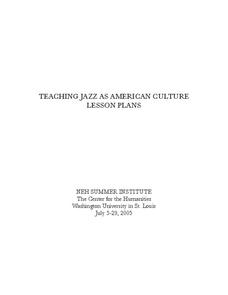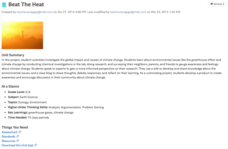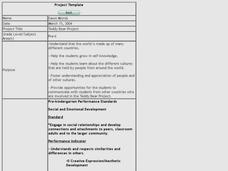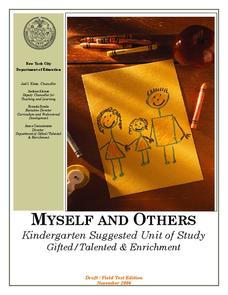Curated OER
Turning Assets into Action in the Fight Against Hunger
How can one person change the world? Scholars research and analyze the topic of world hunger. Using video clips, parodies, and primary source evidence, they uncover a current campaign to end world hunger. Collaborative groups openly...
Washington University in St. Louis
Teaching Jazz as American Culture
Jazz and the City, Jazz and the Civil Rights Movement, Jazz and Gender, Jazz and Literature, Jazz and the Arts, Jazz and Film. Here's a packet of unit plans organized around themes that reflect American culture. Each unit examines how...
Intel
Beat the Heat
Explore greenhouse effect and climate change through a 15-day unit. Scholars learn about these STEM concepts by researching, conducting surveys, experimenting, and collaborating with experts in the field. They frequently communicate...
University of Florida
Investigating the Fungus among Us
What do you call a fungus that writes music? A decomposer! Here, young biologists explore fungus by tasting fungus (blue cheese) to creating art with fungus to playing a board game centered around, you got it, fungus. Surprise...
Columbus City Schools
Get Your Organisms Organized
From large to small, show your class how to organize them all! Included within the guide is everything you need to take their knowledge of classification from the cellular to the species level. The worksheets focus on...
University of Kansas
Newspaper in the Classroom
Newspapers aren't only for reading—they're for learning skills, too! A journalism unit provides three lessons each for primary, intermediate, and secondary grades. Lessons include objectives, materials, vocabulary, and procedure, and...
Curated OER
Studying The Catcher in the Rye
What's the difference between being a phony and being a conformist? At what point does conforming to alleviate loneliness lead to insincerity? These are the questions at the heart of this unit plan that uses The Catcher in the Rye...
Curated OER
Teddy Bear Project
Students take home an Australian Teddy Bear home and draw pictures, photograph, write or verbalize stories of what the bear did at their home. They make a book that is sent to their partner class.
Mathematics Vision Project
Module 6: Trigonometric Functions
Create trigonometric functions from circles. The first lesson of the module begins by finding coordinates along a circular path created by a Ferris Wheel. As the lessons progress, pupils graph trigonometric functions and relate them to...
New York City Department of Education
Myself and Others
Self reflection is an important skill to reinforce in our children, and it's especially helpful to help them realize who they are in the context of their environment. A collection of lessons about self image and community encourage...
Annenberg Foundation
Annenberg Learner: Exploring the World of Music
This 12-video series examines elements of music such as melody, harmony, rhythm, and texture, and how they are used in a wide variety of music genres in cultures around the world.
BBC
Bbc Schools: Gcse Bitesize: Music: Asia, Latin America, and the Middle East
A diverse range of musical styles can be found around the world. Music from Asia, Latin America, and the Middle East all have their own unique musical features and instruments. One of the most influential types of music-making in...
Wonderville Media
Wonderville: Elvis
Elvis Presley is considered the "King of rock 'n' roll." Why? Before Elvis, very few people had ever heard of rock 'n' roll. It was a brand-new style of music. He was the first big rock star and made this new style of music popular...
TED Talks
Ted: Ted Ed: A Different Way to Visualize Rhythm
In standard notation, rhythm is indicated on a musical bar line. But there are other ways to visualize rhythm that can be more intuitive. John Varney describes the 'wheel method' of tracing rhythm and uses it to take us on a musical...












